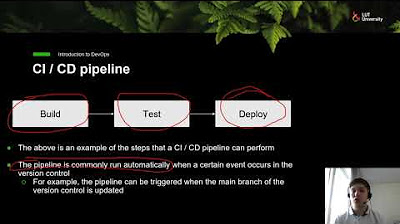How to Run Playwright Tests in Gitlab CI/CD Pipeline
Summary
TLDRThis tutorial demonstrates how to integrate Playwright tests into a GitLab CI/CD pipeline. It covers the process of setting up the environment, writing and running tests, implementing HTML reporting, using GitLab’s Trace Viewer for debugging, and optimizing test execution with Playwright's sharding feature. The video also explains how to set up periodic test schedules for large test suites. Viewers are encouraged to explore further and ask questions in the comments.
Takeaways
- 😀 Create a new project on GitLab and open the pipeline editor to configure the environment and test execution steps.
- 😀 Use the official Playwright image maintained by Microsoft in your GitLab CI/CD pipeline configuration.
- 😀 The initial configuration allows you to run Playwright tests, but HTML reporting will need to be added later.
- 😀 After setting up the pipeline, clone the repository locally and install Playwright to create the test scripts.
- 😀 Playwright's Code Generator can help generate test scripts without needing extensive programming knowledge.
- 😀 Use the SAU demo testing site from SAU Labs for your test automation target, such as login verification.
- 😀 Push the test code to GitLab to trigger the CI/CD pipeline, which will run the Playwright tests automatically.
- 😀 Implement HTML reporting by configuring GitLab to store artifacts and pushing them to GitLab’s interface.
- 😀 Use GitLab’s Trace Viewer to debug failed tests by examining the detailed steps of the test execution.
- 😀 Implement test sharding in Playwright to improve test execution speed by running tests in parallel with multiple shards.
- 😀 Set up a schedule for periodic test execution to avoid running large test suites on every commit, making the pipeline more efficient.
Q & A
What is the first step in setting up GitLab CI/CD pipelines for Playwright tests?
-The first step is to create a new project on GitLab, fill in the necessary details, and proceed to the pipeline editor to create a YAML file outlining the environment configuration and the steps to build and execute the tests.
Why is it important to specify an image in the GitLab CI/CD YAML file?
-Specifying an image in the YAML file ensures that the pipeline uses the correct environment for executing Playwright tests. The script mentions using a Playwright image maintained by Microsoft for this purpose.
What is the role of the HTML reporting in the pipeline process?
-HTML reporting is implemented after confirming that the Playwright tests are running smoothly. It allows users to view detailed reports of test execution directly on GitLab, making it easier to analyze results.
How can you keep HTML reports longer than GitLab’s default artifact retention time?
-To keep the reports longer than GitLab’s default retention time, you can push the reports to an external service like Amazon S3. However, for this tutorial, the focus is on using GitLab’s artifact feature.
What is the benefit of using the trace viewer in GitLab CI/CD pipelines?
-The trace viewer is used to debug failed tests by showing all the steps the test took. It helps pinpoint issues by providing detailed information on the test execution, making it easier to troubleshoot problems.
How does Playwright's test sharding feature improve test execution?
-Playwright's test sharding allows for running large test sets in parallel across multiple test shards, significantly improving execution speed. This is especially beneficial for large test suites.
What is required for setting up test sharding in GitLab CI/CD pipelines?
-To set up test sharding, you need to duplicate the test job, define the shard count, and ensure the test report format is set to Blob report format. Additionally, a separate stage to merge the reports is required, and it must be configured to run always, regardless of test success or failure.
Why is it crucial to merge test reports even when tests fail?
-Merging test reports even when tests fail is important because it provides a complete view of the test execution, including failed runs, which is essential for debugging and understanding the full test outcome.
What happens if you don’t use the 'when: always' configuration in the merging stage?
-Without the 'when: always' line in the merging stage, the merge would only happen if the test runs are successful. However, it's crucial to merge the reports even if the tests fail, to get insights into the failure.
What is the purpose of scheduling periodic test execution in GitLab CI/CD pipelines?
-Scheduling periodic test execution is essential for larger test suites that do not need to be executed on every commit. This ensures that tests are run regularly without overloading the CI/CD system with unnecessary test runs.
Outlines

此内容仅限付费用户访问。 请升级后访问。
立即升级Mindmap

此内容仅限付费用户访问。 请升级后访问。
立即升级Keywords

此内容仅限付费用户访问。 请升级后访问。
立即升级Highlights

此内容仅限付费用户访问。 请升级后访问。
立即升级Transcripts

此内容仅限付费用户访问。 请升级后访问。
立即升级浏览更多相关视频

Setting Up OIDC to Get Credentials from Google Cloud

GitLab | SonarCloud | Code Scan | How to Set Up GitLab Code Scan with SonarCloud | SonarQube

GitLab: DevSecOps: Part 1/12: What is GitLab? The fundamental concepts of a DevSecOps pipeline.

Complete CICD setup with Live Demo | #devops #jenkins| Write CICD with less code| @TrainWithShubham

#1 What is DevOps ,Agile and CICD

Introduction to DevOps - CI / CD
5.0 / 5 (0 votes)
